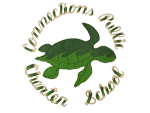|

Can Second-Graders Measure Up?
By Lani Abrigana
Curriculum Research and Development Group

Brows furrowed in
concentration, second-graders at the
Education Laboratory School
work in groups to come up with equations based on diagrams showing 8 and two
of its addends (e.g. 7+1=8, 2+6=8). They are then asked to draw a line
segment representing the relationship of the addends and 8. After a
specified amount of time, teacher/researcher Claire Okazaki calls each group
to come up and explain their answers to their classmates. Another
researcher, Fay Zenigami, observes and takes notes on the lesson, including
how the groups, with varying degrees of confidence, go through their
explanations of how parts relate to a whole.
The second-graders are helping researchers at the
Curriculum Research
and Development Group (CRDG) create a unique elementary mathematics
program called Measure Up. During the past school year and for four weeks
this summer, these students did number, measurement, algebra and geometry
activities for 45 minutes to an hour each day while under observation.
Researchers anticipate that these activities will stimulate the students’
algebraic thinking and foster development of their problem-solving skills
throughout their elementary school years.
The curriculum now being designed and developed for grades 1–5 is based on
preliminary work done by a group of psychologists, mathematicians and
educators in
Krasnoyarsk,
Russia.
CRDG researchers, in collaboration with the Institute for Developmental
Psychology and Pedagogy (IDPP) in Russia, will combine this earlier work
with new findings from pilot-test sites in the U.S. In addition to the
Education Laboratory School, the Connections Public Charter School in Hilo
and a laboratory school associated with IDPP in
Krasnoyarsk,
Russia,
are participating in this phase, which began in August 2001.
The research focuses on the curriculum and its effects on the class as a
whole as well as each student’s growth. The research team uses its daily
observation notes to chart the development of mathematical understandings
and to identify instructional techniques that enhance the learning of
mathematics. The team regularly conducts student interviews to validate or
clarify what it observes in the class. These data are then used to assess
students’ progress in understanding mathematics and identify revisions
needed in the materials that will optimize student learning.
After the pilot-testing phase, the curriculum will be field-tested at other
schools for further refinement and adjustment. Upon completion, materials
will be disseminated nationally and internationally. Measure Up will be a
total curriculum, including materials for students and teachers, along with
professional development institutes for teachers and pre-service education
courses.
Project Director Barbara J. Dougherty said “I have been amazed at the
sophisticated mathematics young children are able to work with. These
children are working with mathematical ideas that are often found in the
middle grades.”
Ultimately, the Measure Up team aims to improve the teaching of elementary
mathematics in order to lay the groundwork for all students to succeed in
higher mathematics. Yes, second-graders can do algebra! |
